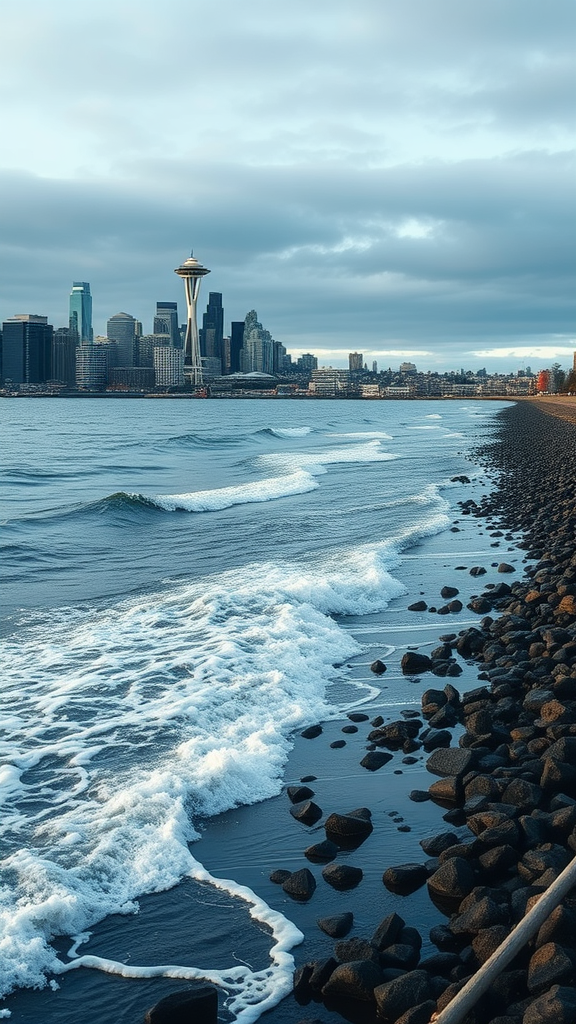Understanding the Patterns of Seattle Elliott Bay Tides: A Guide for Residents and Visitors
Understanding the tides in Seattle’s Elliott Bay is essential for both residents and visitors. The Bay, framed by stunning views of the city skyline and the majestic mountains, has a unique tidal pattern due to its geographic location and the influence of the Pacific Ocean. Knowing how these tides work can enhance your experience whether you’re boating, fishing, or simply enjoying a day at the waterfront.
The Basics of Tidal Movements
Seattle Elliott Bay experiences semidiurnal tides, meaning there are usually two high tides and two low tides every day. The timing and height of these tides can vary significantly due to various factors such as the moon’s phases, weather patterns, and seasonal changes. Here are some key points to remember:
- High Tides: These occur when the water level rises to its peak. High tides in Elliott Bay can vary from 7 to 12 feet above the mean lower low water level.
- Low Tides: Conversely, low tides see the water level drop, often exposing large sections of the tide flats, revealing marine life and beach access.
- Cycle Duration: Tides generally follow a roughly 12-hour and 25-minute cycle, leading to variations in when you can expect high or low water.
Factors Affecting Tidal Patterns
Several factors influence the tidal patterns in Elliott Bay:
- Moon Phases: The moon significantly affects tides. During a full moon or new moon, tides are more pronounced, resulting in what are called spring tides, which lead to higher high tides and lower low tides.
- Weather Conditions: Wind and atmospheric pressure can also alter tides. For instance, a strong onshore wind can push water towards the coast, leading to higher tides.
- Geographical Features: Elliot Bay’s shape and depth create unique tidal behaviors. Narrower inlets can amplify tidal effects, making understanding local tides crucial.
Reading Tidal Charts
For anyone looking to navigate or explore Elliott Bay, understanding tidal charts can be incredibly beneficial. These charts provide information about predicted tide heights and timing. Here’s how to read them:
- Units: Heights are measured in feet relative to the mean lower low water.
- Time Format: Tidal times are usually displayed in PST. Pay close attention to AM and PM indicators.
- Comparison: Note the predicted heights of successive high and low tides to determine the best times for activities like fishing or kayaking.
Best Activities Based on Tides
Elliott Bay offers numerous activities that can be enhanced by understanding the tides:
- Kayaking and Paddleboarding: The best time to paddle is usually during high tide when there is enough water to navigate safely around the bay.
- Fishing: Many anglers prefer to fish during rising tides as fish tend to feed more actively at these times.
- Beachcombing: Low tides reveal exposed beaches; this is the ideal time to explore tidal pools and discover marine life.
- Photography: Capture stunning shots of the waterfront during high tide, showcasing the deeper waters against the skyline.
Safety Tips During Tidal Activities
While exploring the Bay, safety should always be a priority. Here are some tips to keep in mind:
- Monitor Tide Levels: Always check the tide schedule before heading out to prevent getting stranded.
- Wear Proper Gear: Dry suits or wetsuits are advisable for colder days, especially for activities like kayaking.
- Be Aware of Quick Changes: Tides can rise and fall quickly, leading to sudden water level changes that could affect your safety.
Understanding Seattle Elliott Bay tides is not just an interesting aspect of life by the water; it plays a vital role in enjoying the activities and natural beauty the area has to offer. By being informed and prepared, you can make the most of this beautiful bay, whether you’re a local or a visitor.
The Impact of Tides on Marine Life and Activities in Seattle’s Elliott Bay
The tides of Elliott Bay in Seattle play a vital role in the ecosystem and activities that thrive in the local area. Understanding the influence of these tides gives insights into the marine life and recreational opportunities that abound here.
Understanding Tides in Elliott Bay
The tides in Elliott Bay are the result of the gravitational pull from the moon and the sun, along with the geography of the bay itself. Each day, you can expect two high tides and two low tides, creating a rhythm that affects both marine organisms and human activities.
The Influence on Marine Life
Tides create a dynamic environment that marine life depends on for survival. Here are some key impacts:
- Feeding Opportunities: Many marine species, such as crabs and clams, thrive during low tide when they can be easily accessed by birds and other predators. This makes tidal fluctuations critical for their feeding habits.
- Habitat Creation: Areas exposed during low tide enable the growth of tide pools filled with various organisms like starfish, anemones, and snails. These pools act as mini-ecosystems supporting life.
- Breeding Cycles: Certain fish species, including salmon, time their spawning cycles with tides. The rise and fall of water levels can help fry travel to safer environments away from predators.
Impact on Recreational Activities
Elliott Bay is not just a haven for marine life; it’s also a playground for people. The changing tides influence various recreational activities:
- Kayaking and Paddleboarding: The best times to paddle are often during high tide when the water level is up. Lower tides can lead to rocky areas that might be difficult to navigate.
- Fishing: Many local fishermen know that certain fish are more active during specific tidal conditions. Understanding this can lead to better catches.
- Beachcombing: Low tides are perfect for exploring the sandy and rocky shores. You can find interesting shells, marine plants, and sometimes even the occasional sea glass.
Safety Considerations
While the tides create fantastic opportunities, they also require caution. It’s essential to monitor tide charts when planning activities in Elliott Bay to avoid unexpected changes. Here are some tips:
- Check the tide schedule before heading out, ensuring you know when high and low tides will occur.
- Be mindful of the currents during strong tidal changes, as they can be powerful and swift.
- Always keep an eye on the shoreline; it can change quickly with the tides.
The Role of Community and Conservation
Local organizations often monitor tides and share information about their impact on both marine life and recreational activities. Community engagement is essential for maintaining the delicate balance of the ecosystem. Here’s how you can get involved:
- Join Community Clean-Ups: Help keep Elliott Bay clean to protect marine life from pollution.
- Participate in Educational Programs: Many local programs provide knowledge about the tide cycles and their effects.
- Advocate for Protection: Support initiatives aimed at conserving natural habitats within the bay.
The tides of Elliott Bay are not just a matter of rising and falling water; they weave a complex tapestry vital for life, recreation, and community engagement. Whether you’re exploring the tide pools, fishing, or paddling, understanding the tides enriches your experience and fosters increased respect for this incredible ecosystem.
By appreciating the impact of tides on both marine life and leisure activities, you become part of the effort to maintain the natural beauty and vibrancy of Elliott Bay. So, the next time you visit, take a moment to observe and reflect on this beautiful ebb and flow of nature.
Conclusion
Understanding the patterns of Seattle Elliott Bay tides is essential for both residents and visitors to fully appreciate the natural beauty and dynamics of this vibrant coastal area. By grasping how the tides work, you can better plan your day—whether it’s enjoying a relaxing stroll along the shoreline, engaging in recreational activities, or exploring the unique marine ecosystems that thrive in the Bay.
The impact of these tides extends far beyond mere aesthetics; they play a crucial role in supporting diverse marine life. For instance, tidal changes influence the feeding habits of various fish and bird species that call Elliott Bay home. As a visitor or local, you can witness the fascinating interactions between tides and wildlife, highlighting the interconnectedness of our environment.
Moreover, understanding Seattle’s tidal patterns can enhance your recreational experiences. You’ll find that fishing, kayaking, and other water sports are best enjoyed at specific tide levels. By keeping track of tide schedules, you can maximize your enjoyment and ensure a safe outing, whether you choose to venture out for an adventurous day on the water or take a peaceful moment to observe the ebb and flow of the waves.
Being informed about Seattle Elliott Bay tides enriches your experience and increases your appreciation for this stunning location. Embrace this knowledge and let it guide your adventures around Elliott Bay, allowing you to connect more deeply with its natural rhythms and the incredible marine life that thrives within it.

